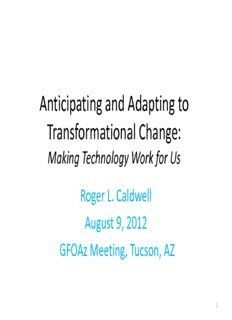
Anticipating and Adapting to Transformational Change PDF
Preview Anticipating and Adapting to Transformational Change
Anticipating and Adapting to Transformational Change: Making Technology Work for Us Roger L. Caldwell August 9, 2012 GFOAz Meeting, Tucson, AZ 1 Many interactions, changing independently and together Technology + Human Skills Public + Change + Private Adapt Management + Transparency 2 Change and Odiorne (1981) • Recognize and avoid groupthink • When experts disagree, do not plunge • When all evidence points in one direction, do not assume the opposite • Use feedback of facts as new situations emerge 3 Dealing with Change (from 35 Change Codes 1995) • Expect change and the unexpected • Expect a bumpy ride but for change to evolve • Don’t rely too much on forecasts • Don’t penalize mistakes • Walk a mile in their shoes 4 Four Parts 1. Learning More About the Future 2. Focusing on Technology 3. Adapting to Change 4. What Should We Do? (new slides since your packed was distributed are indicated with * and order is changed) (additional slides posted on my website) 5 Part 1 Learning More About the Future 6 The Need for a New Mindset: Understanding Transitions Between Eras • The Problem is that we live in a VUCA world: – Volatile, Uncertain, Complex, and Ambiguous • The historic solutions include: – 1) Appoint a committee, 2) watch others and try modifications of past successful efforts, 3) reorganize, and 4) provide three envelopes to the unit leader • A better solution is to be FAIR – Flexible, Agile, Innovative, and Responsive 7 Institute for the Future (2012) 8 Why Anticipate the Future? • To make better decisions today • Because you will spend the rest of your life there • Growing awareness that significant changes will happen – and adaptation is necessary 9 How to Anticipate the Future • Know something about the past (~ 30 + years) • Understand role of key driving forces of change and their implications; change is getting faster • Develop relevant scenarios for understanding possible futures (planned or unplanned) • Make realistic assumptions but don’t be too cautious and end up moving too slowly 10
Description: